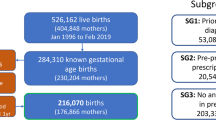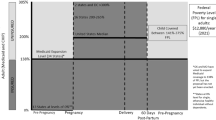Abstract
Objective:
The American College of Obstetricians and Gynecologists and the American Psychiatric Association both recommend pharmacotherapy for perinatal depression when the benefits outweigh the risks. While minority adults are less likely to use antidepressant medications compared with non-Hispanic Whites, whether this pattern occurs among pregnant women is unclear. We sought to determine the frequency of antidepressant medication use reported during ambulatory care visits for pregnant women and whether these rates varied by race.
Study Design:
We combined the 2006–2010 National Ambulatory Medical Care Survey and the National Hospital Ambulatory Medical Care Survey to obtain nationally representative estimates of outpatient preventive care visits for pregnant women. We then obtained estimates of the prevalence of reported depression and antidepressant use during outpatient visits for pregnant women. To determine whether these estimates varied by race, we used multivariable logistic regression analyses accounting for survey design using SAS 9.2 (PROC SURVEYLOGISTIC) to estimate odds ratios of reported antidepressant use after adjustment for age, insurance status and region of the country.
Result:
Antidepressant use was reported during 2.2% of all outpatient visits for pregnant women. Providers indicated a depression diagnosis in 4.5% of visits. Among visits for depressed pregnant women, providers reported antidepressant use 25.4% of the time for all visits. Antidepressant use during pregnancy varied significantly by race/ethnicity. Among visits for non-Hispanic White women, 3.1% included a code for antidepressant use vs just 1.0% for non-White women (P<0.0001). After adjustment for age, insurance status and region of the country, this association persisted with non-Hispanic White (vs non-White) pregnant women having higher odds of antidepressant use (adjusted OR 3.3, 95% confidence intervals 2.1, 5.3).
Conclusion:
Non-Hispanic White women were more likely than non-White women to be using antidepressants during pregnancy. Whether differences in antidepressant use by race/ethnicity indicates over-treatment of non-Hispanic White women or under-treatment of minorities remains unclear. This disparity warrants investigation with the goal of optimizing maternal mental health while minimizing potential adverse sequelae of antidepressants on developing fetuses.
This is a preview of subscription content, access via your institution
Access options
Subscribe to this journal
Receive 12 print issues and online access
$259.00 per year
only $21.58 per issue
Buy this article
- Purchase on Springer Link
- Instant access to full article PDF
Prices may be subject to local taxes which are calculated during checkout

Similar content being viewed by others
References
Centers for Disease Control and Prevention. Current depression among adults — United States, 2006 and 2008. MMWR 2010; 59: 1229–1235.
Gaynes BN, Gavin N, Meltzer-Brody S, Lohr KN, Swinson T, Gartlehner G et al. Perinatal depression: prevalence, screening accuracy, and screening outcomes. Evid Rep Technol Assess (Summ) 2005; 119: 1–8.
Centers for Disease Control and Prevention. Depression Among Women of Reproductive Age. Am Fam Physician 2013; 87 (1): 30–37.
Dietz PM, Williams SB, Callaghan WM, Bachman DJ, Whitlock EP, Hornbrook MC . Clinically identified maternal depression before, during, and after pregnancies ending in live births. Am J Psychiatry 2007; 164: 1515–1520.
Munizza C, Argentero P, Coppo A, Tibaldi G, Di Giannantonio M, Picci RL et al. Public beliefs and attitudes towards depression in Italy: a national survey. PLoS One 2013; 8: e63806.
Ko JY, Farr SL, Dietz PM, Robbins CL . Depression and treatment among U.S. pregnant and nonpregnant women of reproductive age, 2005-2009. J Womens Health (Larchmt) 2012; 21: 830–836.
Meunier MR, Bennett IM, Coco AS . Use of antidepressant medication in the United States during pregnancy, 2002-2010. Psychiatr Serv 2013; 64: 1157–1160.
Yonkers KA, Wisner KL, Stewart DE, Oberlander TF, Dell DL, Stotland N et al. The management of depression during pregnancy: a report from the American Psychiatric Association and the American College of Obstetricians and Gynecologists. Gen Hosp Psychiatry 2009; 31: 403–413.
Huang H, Coleman S, Bridge JA, Yonkers K, Katon W . A meta-analysis of the relationship between antidepressant use in pregnancy and the risk of preterm birth and low birth weight. Gen Hosp Psychiatry 2014; 36: 13–18.
Reis M, Kallen B . Delivery outcome after maternal use of antidepressant drugs in pregnancy: an update using Swedish data. Psychol Med 2010; 40: 1723–1733.
Sanz EJ, De-las-Cuevas C, Kiuru A, Bate A, Edwards R . Selective serotonin reuptake inhibitors in pregnant women and neonatal withdrawal syndrome: a database analysis. Lancet 2005; 365: 482–487.
Urato AC, Mintzes B, Mangin D, Jureidini J . Diagnosis, pathophysiology, and management of mood disorders in pregnant and postpartum women. Obstet Gynecol 2011; 118: 708; author reply 708–709.
Yonkers KA, Vigod S, Ross LE . Diagnosis, pathophysiology, and management of mood disorders in pregnant and postpartum women. Obstet Gynecol 2011; 117: 961–977.
Urato AC, Mintzes B, Mangin D, Jureidini J . Diagnosis, pathophysiology, and management of mood disorders in pregnant and postpartum women. Obstet Gynecol 118: 708; author reply 708–709.
Dubnov-Raz G, Koren G, Finkelstein Y . Selective serotonin reuptake inhibitor exposure in pregnancy and neonatal adverse events. Arch Pediatr Adolesc Med 2010; 164: 394; author reply 394–395.
Siddique J, Chung JY, Brown CH, Miranda J . Comparative effectiveness of medication versus cognitive-behavioral therapy in a randomized controlled trial of low-income young minority women with depression. J Consult Clin Psychol 2012; 80: 995–1006.
DeRubeis RJ, Siegle GJ, Hollon SD . Cognitive therapy versus medication for depression: treatment outcomes and neural mechanisms. Nat Rev Neurosci 2008; 9: 788–796.
Siegel CE, Wanderling J, Haugland G, Laska EM, Case BG . Access to and use of non-inpatient services in New York State among racial-ethnic groups. Psychiatr Serv 2013; 64: 156–164.
Cooper WO, Willy ME, Pont SJ, Ray WA . Increasing use of antidepressants in pregnancy. Am J Obstet Gynecol 2007; 196 (544): e541–e545.
Alegria M, Chatterji P, Wells K, Cao Z, Chen CN, Takeuchi D et al. Disparity in depression treatment among racial and ethnic minority populations in the United States. Psychiatr Serv 2008; 59: 1264–1272.
Gavin AR, Melville JL, Rue T, Guo Y, Dina KT, Katon WJ . Racial differences in the prevalence of antenatal depression. Gen Hosp Psychiatry 2011; 33: 87–93.
Orr ST, Blazer DG, James SA . Racial disparities in elevated prenatal depressive symptoms among black and white women in eastern North Carolina. Ann Epidemiol 2006; 16: 463–468.
Taveras EM, Gillman MW, Kleinman K, Rich-Edwards JW, Rifas-Shiman SL . Racial/ethnic differences in early-life risk factors for childhood obesity. Pediatrics 2010; 125: 686–695.
O'Mahen HA, Henshaw E, Jones JM, Flynn HA . Stigma and depression during pregnancy: does race matter? J Nerv Ment Dis 2011; 199: 257–262.
Centers for Disease Control and Prevention. National Center for Health Statistics. Ambulatory Health Care Data. [cited 2013 December 4]. Available from http://www.cdc.gov/nchs/ahcd.htm.
Yamamoto A, McCormick MC, Burris HH . US Provider-Reported Diet and Physical Activity Counseling to Pregnant and Non-pregnant Women of Childbearing Age During Preventive Care Visits. Matern Child Health J 2013; 18 (7): 1610–1618.
Multum Lexicon Drug Database Description. [cited 2013 December 21]. Available from www.multum.com/Lexicon.html.
Centers for Disease Control and Prevention. Trend Analysis Using NAMCS and NHAMCS Drug Data. 2010.
Centers for Disease Control and Prevention, National Center for Health Statistics. 2010 NHAMCS Micro-data file documentation. 2010 [cited 2012 November 4]. Available from ftp://ftp.cdc.gov/pub/Health_Statistics/NCHS/Dataset_Documentation/NHAMCS/doc2010.pdf.
Centers for Disease Control and Prevention, National Center for Health Statistics. 2010 NAMCS Micro-data file documentation. 2010 [cited 2012 November 5]. Available from ftp://ftp.cdc.gov/pub/Health_Statistics/NCHS/Dataset_Documentation/NAMCS/doc2010.pdf.
Burris HH, Werler MM . US provider reported folic acid or multivitamin ordering for non-pregnant women of childbearing age: NAMCS and NHAMCS, 2005-2006. Matern Child Health J 2010; 15: 352–359.
Campagne DM . The obstetrician and depression during pregnancy. Eur J Obstet Gynecol Reprod Biol 2004; 116: 125–130.
Chaudron LH . Complex challenges in treating depression during pregnancy. Am J Psychiatry 2013; 170: 12–20.
Gavin AR, Tabb KM, Melville JL, Guo Y, Katon W . Prevalence and correlates of suicidal ideation during pregnancy. Arch Womens Ment Health 2011; 14: 239–246.
Kingston D, Tough S, Whitfield H . Prenatal and postpartum maternal psychological distress and infant development: a systematic review. Child Psychiatry Hum Dev 2012; 43: 683–714.
Liu CH, Tronick E . Rates and predictors of postpartum depression by race and ethnicity: results from the 2004 to 2007 New York City PRAMS survey (Pregnancy Risk Assessment Monitoring System). Matern Child Health J 2012; 17: 1599–1610.
Nulman I, Koren G, Rovet J, Barrera M, Pulver A, Streiner D et al. Neurodevelopment of children following prenatal exposure to venlafaxine, selective serotonin reuptake inhibitors, or untreated maternal depression. Am J Psychiatry 2012; 169: 1165–1174.
Kallen B, Olausson PO . Maternal use of selective serotonin re-uptake inhibitors and persistent pulmonary hypertension of the newborn. Pharmacoepidemiol Drug Saf 2008; 17: 801–806.
Clements CC, Castro VM, Blumenthal SR, Rosenfield HR, Murphy SN, Fava M et al. Prenatal antidepressant exposure is associated with risk for attention-deficit hyperactivity disorder but not autism spectrum disorder in a large health system. Mol Psychiatry 2014.
Domar AD, Moragianni VA, Ryley DA, Urato AC . The risks of selective serotonin reuptake inhibitor use in infertile women: a review of the impact on fertility, pregnancy, neonatal health and beyond. Hum Reprod 2012; 28: 160–171.
McDonagh MS, Matthews A, Phillipi C, Romm J, Peterson K, Thakurta S et al. Depression drug treatment outcomes in pregnancy and the postpartum period: a systematic review and meta-analysis. Obstet Gynecol 2014; 124: 526–534.
Faramarzi M, Alipor A, Esmaelzadeh S, Kheirkhah F, Poladi K, Pash H . Treatment of depression and anxiety in infertile women: cognitive behavioral therapy versus fluoxetine. J Affect Disord 2008; 108: 159–164.
Yonkers KA, Ramin SM, Rush AJ, Navarrete CA, Carmody T, March D et al. Onset and persistence of postpartum depression in an inner-city maternal health clinic system. Am J Psychiatry 2001; 158: 1856–1863.
Shen JJ, Lin F, Jackson T . Risk of prenatal depression: differences by race. Ethn Dis 2010; 20: 35–39.
Koyanagi C, Forquer S, Alfano E . Medicaid policies to contain psychiatric drug costs. Health Aff (Millwood) 2005; 24: 536–544.
Spitzer WO . Bias versus causality: interpreting recent evidence of oral contraceptive studies. Am J Obstet Gynecol 1998; 179: S43–S50.
Acknowledgements
The authors thank the Centers for Disease Control and Prevention and the participating patients and providers who contributed to NAMCS and NHAMCS. The last author is funded by the Klarman Scholars Program and by NIH/NIEHS K23-ES022242.
Author information
Authors and Affiliations
Corresponding author
Ethics declarations
Competing interests
The authors declare no conflict of interest.
Rights and permissions
About this article
Cite this article
Yamamoto, A., McCormick, M. & Burris, H. Disparities in antidepressant use in pregnancy. J Perinatol 35, 246–251 (2015). https://doi.org/10.1038/jp.2014.197
Received:
Revised:
Accepted:
Published:
Issue Date:
DOI: https://doi.org/10.1038/jp.2014.197
This article is cited by
-
Physician Referrals During Prenatal Care
Maternal and Child Health Journal (2021)
-
Selective serotonin reuptake inhibitor use patterns among commercially insured US pregnancies (2005–2014)
Archives of Women's Mental Health (2021)
-
Treatment and Management of Depression Symptoms in Pregnant Veterans: Varying Experiences of Mental Health Care in the Prenatal Period
Psychiatric Quarterly (2020)



